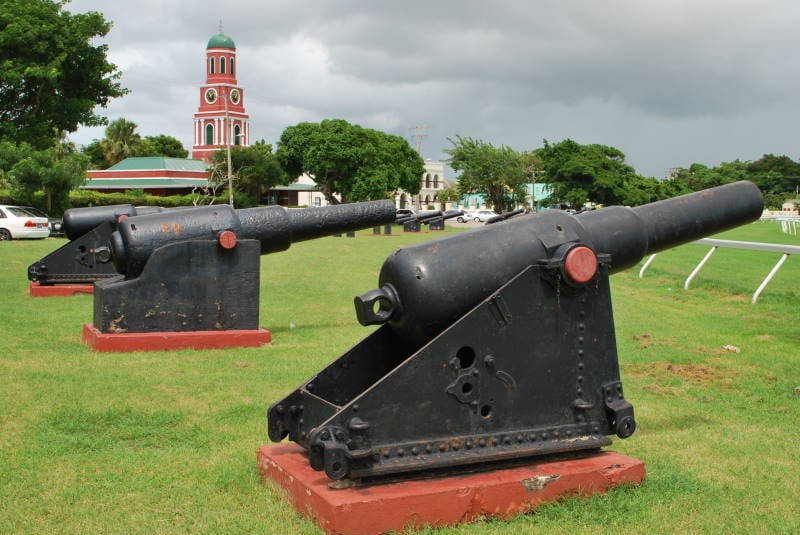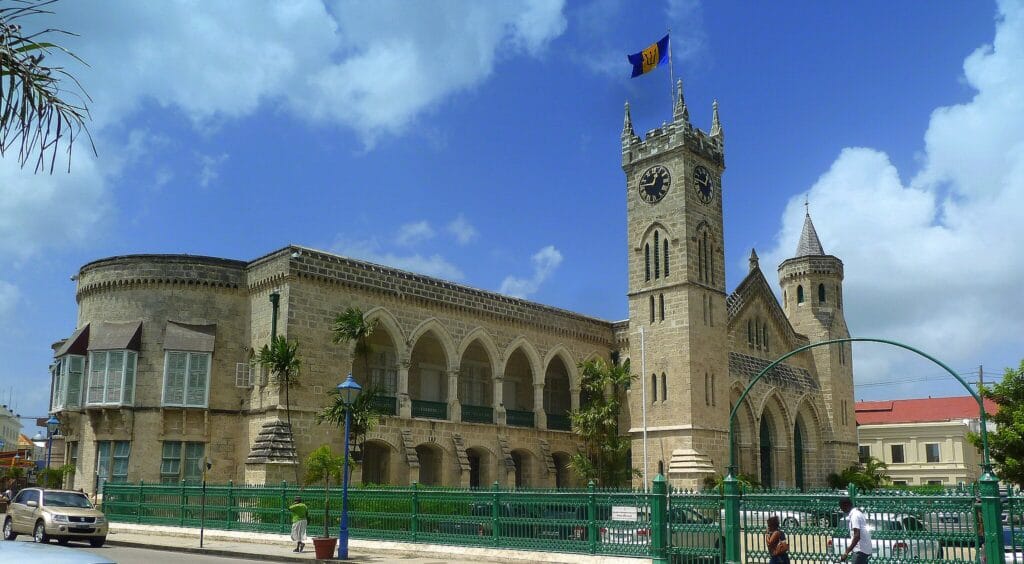Bridgetown in Barbados
Bridgetown is not only the capital and largest city of Barbados but also a popular destination for visitors. It attracts many tourists with its rich history, vibrant culture, and beautiful beaches. The city is conveniently located for shopping, dining, and enjoying nightlife. You’ll find many historic sites to explore, like the Barbados Parliament Buildings and the UNESCO-recognized area known as Bridgetown and Garrison. The unique mix of old buildings and modern amenities makes Bridgetown a great place to experience the culture of Barbados.
Table of Contents
Where is the location of Bridgetown?

Bridgetown is the capital of Barbados, located on the southwestern coast of the island. It sits along Carlisle Bay, which is part of the beautiful Caribbean Sea. As the biggest city in Barbados, Bridgetown plays an important role as the country’s leading center for finance, culture, and business activities.
Inscription of Bridgetown
Bridgetown and Garrison in Barbados became a UNESCO World Heritage Site in 2011. This title recognizes the area’s rich history and unique buildings. Bridgetown is connected to British colonial history, and its well-kept military structures play a big part in why it received this honor. The town showcases a blend of British and Caribbean architectural styles, which makes it even more special.
The Garrison area includes important military buildings like barracks, a parade ground, and a fort, all of which have been well preserved. The UNESCO designation highlights how significant Bridgetown was as a center for trade and defense during the British Empire, shaping the town’s history and importance.
What is the history of Bridgetown and Garrison?

Bridgetown and Garrison are among the earliest towns built with a strong port in the Caribbean. They played a key role for the British, serving as an important military and trade center in the Atlantic. During the 17th century, Bridgetown became increasingly important for British trade, primarily known for its sugar production. It was also a significant location for the transportation of enslaved people to Barbados and various other areas in the Americas.
Historic Bridgetown featured a fortified port that linked the Bay Street area to St. Ann’s Garrison. Carlisle Bay, a natural harbor, was the first stop for ships traveling across the Atlantic Ocean. Its strategic location allowed British forces to safeguard and expand their trade in the area. The Garrison acted as the central command center for the British Army and Navy in the Eastern Caribbean.
Historic Bridgetown and Garrison played a key role in trading goods and enslaved people. They also contributed to sharing ideas and cultures that shaped the colonial development in the Atlantic World.
What is the history of St Ann’s Garrison?

St. Ann’s Garrison is an important military site located just outside Bridgetown, the capital of Barbados. It is one of the most well-preserved examples of British military history in the Caribbean. In 2011, St. Ann’s Garrison and Historic Bridgetown were recognized as UNESCO World Heritage Sites, acknowledging their historical importance and role in British military history in the Caribbean. The buildings at the Garrison showcase beautiful British colonial architecture from the 18th and 19th centuries. Many of these structures have been restored and are now used as government offices, museums, and cultural centers, allowing visitors to appreciate their history and significance.
Parliament Buildings

The Parliament Buildings in Bridgetown, Barbados, are essential and well-known structures. They are located in the center of Bridgetown and play a key role in Barbados’ political history. Barbados has the third-oldest parliamentary democracy in the Commonwealth, which started in 1639. The Parliament Buildings are part of the Historic Bridgetown, a UNESCO World Heritage Site. This designation highlights their significance in history, architecture, and culture, reflecting Barbados’ colonial and post-colonial history. The buildings are still the headquarters of the government and are popular destinations for tourists interested in culture and history.
Mutual Building

The Mutual Building is located in Bridgetown, Barbados, an important example of early 20th-century architecture. It was built for the Barbados Mutual Life Assurance Society, one of the oldest insurance companies in the Caribbean. This company played a significant role in the island’s economic history. The Mutual Building and other colonial-era buildings are a key part of Bridgetown’s historical center. Its architectural importance and its role in developing the island’s financial sector make it an essential part of Barbados’ heritage.
The building is protected because of its cultural and historical significance as part of Historic Bridgetown and Garrison. The Mutual Building reminds us of Barbados’ colonial past and the critical role that financial institutions have played in its economy. It remains a well-maintained feature of the city’s architecture and represents the heritage of one of the Caribbean’s longest-standing insurance companies.
Garrison Clock Tower

The Garrison Clock Tower is an essential historical landmark in St. Ann’s Garrison. In 2011, it was recognized as part of a UNESCO World Heritage Site, the Historic Bridgetown. The clock tower has notable architecture and historical value, playing a key role in preserving Barbados’ colonial past, especially its military history. Many visitors enjoy the clock tower because it offers insight into the island’s role in British military planning during colonial times. It also connects to the architectural and historical story of Bridgetown. The Garrison Clock Tower is a well-preserved symbol of military history and remains an important part of Barbados’s identity and heritage.
St. Mary’s Church

St. Mary’s Church is an active religious site in Barbados and is essential for visitors and locals alike. It attracts many tourists interested in the island’s history and architecture. The church is part of Historic Bridgetown and Garrison, which UNESCO recognized as a World Heritage Site in 2011. Located on Lower Broad Street in the heart of Bridgetown, it is easy for visitors to find. The church is open to the public, and many people come to admire its design, attend services, or explore the old cemetery. St. Mary’s Church stands out for its calm atmosphere, offering a peaceful escape from the busy capital and a place for relaxation for those who visit.
Where is Carlisle Bay?

Carlisle Bay is a beautiful natural harbor on the southwest coast of Barbados, near Bridgetown, the island’s capital. It is known for its lovely crescent-shaped beach, clear blue waters, and various marine life, making it a famous spot for tourists and locals. The bay has historical importance as it served as a key port for British naval and commercial ships during colonial times. Carlisle Bay is famous for excellent snorkeling and diving, thanks to its many sunken ships. These wrecks have become homes for various sea creatures, including colorful fish, turtles, and rays.
What is Bridgetown famous for?
Bridgetown is the capital of Barbados, known for its fascinating history, lively culture, and beautiful beaches. The city is home to impressive old buildings like National Heroes Square and St. Michael’s Cathedral, which reflect its colonial past. Bridgetown is also recognized as a UNESCO World Heritage Site, highlighting its importance in history. Visitors love exploring the bustling markets, especially the Cheapside Market, and enjoying the nearby gorgeous beaches like Carlisle Bay. With its delicious local food and friendly atmosphere, Bridgetown is a favorite spot for travelers.
Why do we need to preserve Bridgetown significantly for us and future generations?

Preserving Bridgetown is essential for several reasons. First, it holds historical and cultural significance, representing the community’s heritage and identity. Maintaining its architecture and landmarks allows us to connect with our past and educate future generations. Additionally, preserving its environment fosters biodiversity and sustainability, ensuring that natural resources remain accessible. Finally, a well-preserved Bridgetown can boost tourism and local economies, benefiting current residents while providing a vibrant and meaningful place for future generations to thrive.
Why should you visit Historic Bridgetown as a visitor?

Historic Bridgetown, recognized as a UNESCO Heritage Site, is a destination that every traveler should experience. This area is full of history and culture, featuring beautiful old buildings that tell a captivating story. Visitors can wander through the charming streets, see essential places like the Barbados Parliament Buildings and St Ann’s Garrison, and soak up the lively atmosphere of this significant cultural spot.
Are you ready to immerse yourself in the vibrant atmosphere of one of the Caribbean’s most significant cultural sites in Bridgetown, Barbados?
Whether you’re a history buff, a foodie, or simply looking for relaxation, Bridgetown has something for everyone. Don’t wait any longer plan your trip to Barbados and experience the charm of Bridgetown for yourself! Book your flight now and start your journey into this Caribbean treasure!
When you’re planning your adventure, enhance your travel experience by using trusted websites like GetYourGuide and Trip.com! These platforms offer a variety of enjoyable tours, activities, and accommodation options to suit every traveler’s needs.
- GetYourGuide offers a wide variety of unforgettable travel experiences. You can choose from tickets to Popular Attractions, Transportation Options, City Passes, Guided Tours, Hop-on Hop-off Bus Services, Water Activities, Day trips, and Trips that last several days in many locations around the world.
- Trip.com makes it easy to combine Flights and Hotels, Trains, Car Rentals, Airport Transfers and Attractions & Tours to create the perfect travel package tailored just for you.
Start your journey with our reliable travel partners and unlock the best of Bridgetown and beyond!
Disclaimer
In this post, affiliate links are included and those links are associated with well-known travel companies such as GetYourGuide and Trip.com. If you choose to purchase or book a service using those links, we may earn a commission at no additional cost to you. We focus on recommending products and services that are helpful to you and we appreciate your support!
Conclusion
We hope you find this information helpful for your next trip. If you want to learn more, check out our other travel blog posts. We cover many topics, including amazing places to visit and helpful travel tips. Whether you’re looking for hidden gems, new cultures, or helpful advice, there’s something for everyone.
Additionally, If you enjoyed the information we shared, don’t forget to explore our other travel product reviews to make your journey even better! Please take a moment to look through our previous posts and let your sense of adventure guide you on your next journey! We wish you happy travels and look forward to sharing more with you in our next blog post!




